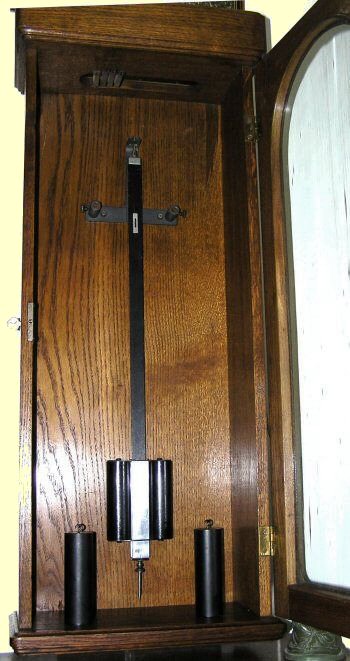Here is the case with the movement removed. At the top is a stout cast iron crucifix bracket, that holds both the pendulum and the clock's movement. At the end of the bracket's arms there are hefty cast bushes with a thumb screw projecting from their sides. These take the three securing rods that stick out from the back of the clock movement.
The pendulum, which can be seen hanging from the bracket at the top, has a slot in it (can be seen in the picture) to accommodate a pin attached to the crutch on the movement.
The rod itself is wood with two cast iron bobs. The way the bob is arranged gives a moderate amount of thermal compensation.
The rating nut at the bottom supports the two central aluminium bars: one of them can be seen in the front. The two bobs are held in a cradle which inturn rests on top of these aluminium bars. These bars are free to expand and contract, as they pass through slots in the bottom of the cradle, rather than the cradle and bars being attached to each other.
If the weather gets warmer (it does occasionally in the UK) then the pendulum rod will expand downwards. At the same time the central aluminium bars will expand and push the cradle, holding the pendulum bobs, upwards. Aluminium expands a lot more than wood, so the longer wooden rod and the shorter aluminium bars should hopefully expand the same amount and cancel each other out.
The rate of any clock is controlled by where the centre point of mass is in the pendulum. This will be approximatively just up from the centre of the carrier, as the rod and suspension spring at the top all have mass that counts as well. The purpose of thermal compensation is to keep this centre of mass in the same place regardless of any expansion caused by heat.






